What Does DNA Stand For in English

Written by
Ernest Bio Bogore

Reviewed by
Ibrahim Litinine
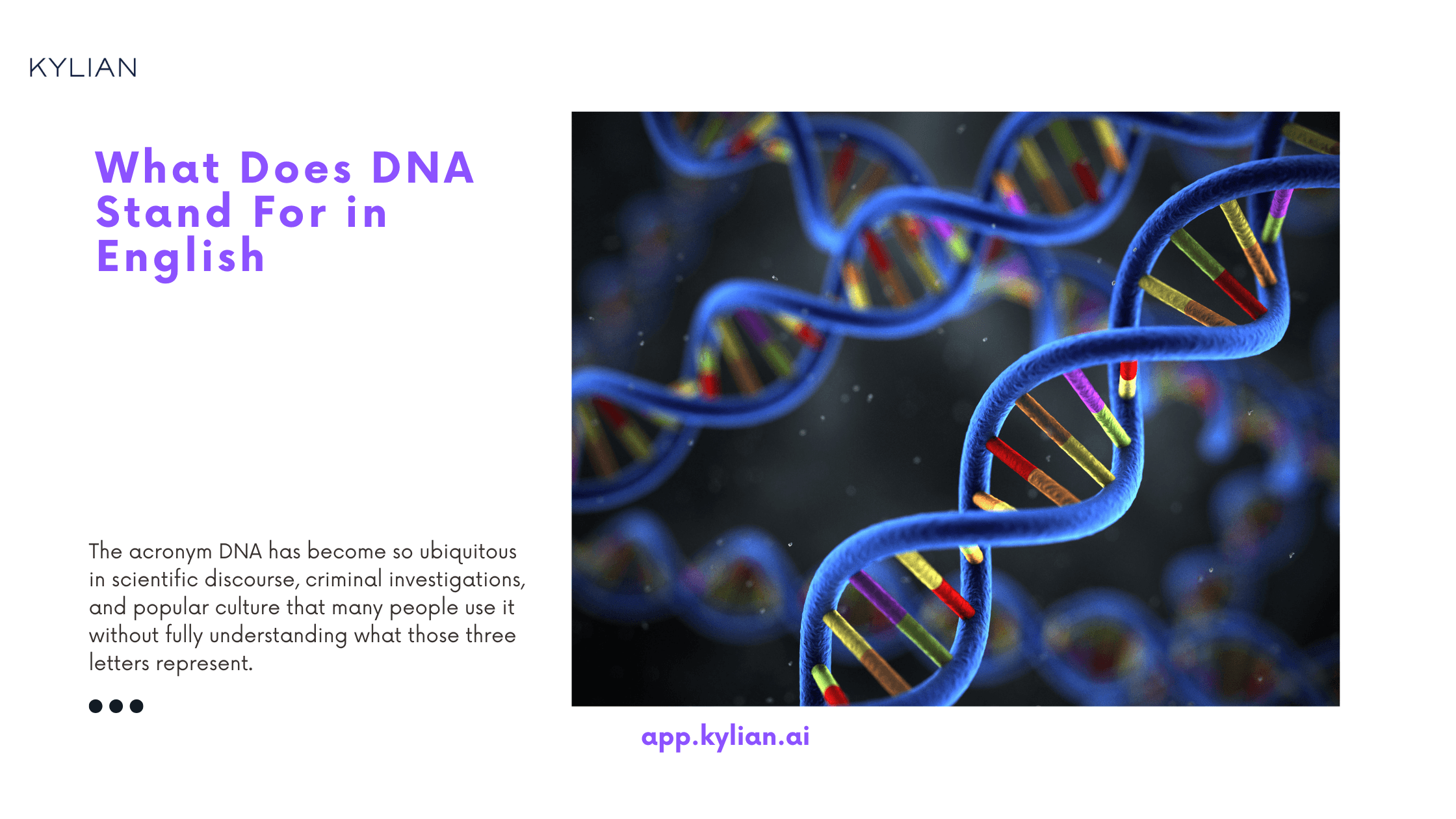
DNA stands for Deoxyribonucleic Acid—three words that represent the most fundamental molecule of life on Earth. This chemical compound carries the genetic instructions that determine every characteristic of living organisms, from the color of your eyes to your susceptibility to certain diseases.
The acronym DNA has become so ubiquitous in scientific discourse, criminal investigations, and popular culture that many people use it without fully understanding what those three letters represent. Yet grasping the meaning behind this abbreviation unlocks understanding of how life itself operates at the molecular level.
Breaking Down the DNA Acronym
The term "Deoxyribonucleic Acid" reveals critical information about DNA's chemical structure and function. Each component of this name carries specific scientific significance that directly relates to how DNA operates within cells.
Deoxy refers to the absence of one oxygen atom compared to ribose sugar. This seemingly minor difference has profound implications for DNA's stability and longevity. The missing oxygen atom makes DNA significantly more stable than its RNA counterpart, allowing it to serve as the permanent storage system for genetic information.
Ribonucleic indicates the presence of ribose, a five-carbon sugar that forms the backbone of the DNA molecule. This sugar provides the structural framework that connects individual nucleotides into the famous double helix configuration. The ribose component enables DNA to maintain its shape while remaining flexible enough for cellular processes like replication and transcription.
Acid designates DNA's chemical classification as a nucleic acid. This acidic nature stems from the phosphate groups that link sugar molecules together, creating a negatively charged backbone. This chemical property influences how DNA interacts with proteins and other cellular components, facilitating essential biological processes.
Historical Context: When DNA Got Its Name
Scientists first isolated DNA in 1869, but the molecule didn't receive its current name until decades later. Friedrich Miescher initially called it "nuclein" because he extracted it from cell nuclei. The term "nucleic acid" emerged in the 1890s when researchers recognized its acidic properties.
The specific designation "deoxyribonucleic acid" wasn't established until 1929, when Phoebus Levene identified the structural differences between DNA and RNA. This naming convention reflected advancing understanding of molecular biology and established the foundation for modern genetic research.
The widespread adoption of the DNA acronym occurred during the 1950s, coinciding with James Watson and Francis Crick's discovery of DNA's double helix structure. This breakthrough transformed DNA from an obscure biochemical compound into a household term that represents the essence of heredity and biological identity.
DNA's Chemical Structure Explained
Understanding what DNA stands for requires examining its molecular architecture. DNA consists of four fundamental components that work together to store and transmit genetic information with remarkable precision.
The basic building blocks, called nucleotides, contain three essential parts: a phosphate group, a deoxyribose sugar, and one of four nitrogenous bases (adenine, thymine, guanine, or cytosine). These components arrange themselves in specific patterns that enable DNA to function as a biological information storage system.
The double helix structure emerges from complementary base pairing between two DNA strands. Adenine always pairs with thymine, while guanine pairs with cytosine. This predictable pairing mechanism ensures accurate DNA replication and provides redundancy that protects genetic information from errors.
Each human cell contains approximately 3.2 billion base pairs of DNA, stretched across 23 chromosome pairs. If you could unwind all the DNA in a single cell and lay it end-to-end, it would measure about six feet in length—yet it fits within a cell nucleus measuring only 10 micrometers in diameter.
Why DNA's Full Name Matters in Science
The complete term "deoxyribonucleic acid" provides crucial information that the simple acronym obscures. Scientific precision requires understanding these molecular details because they directly impact DNA's biological functions and practical applications.
The "deoxy" prefix distinguishes DNA from RNA (ribonucleic acid), highlighting DNA's superior stability for long-term information storage. This stability makes DNA suitable for preserving genetic information across generations, while RNA serves more transient functions in protein synthesis and gene regulation.
Research applications often depend on understanding DNA's chemical properties. Forensic scientists leverage DNA's stability to extract genetic profiles from degraded samples. Medical researchers exploit specific chemical characteristics to develop gene therapies and diagnostic tools. Biotechnology companies manipulate DNA's predictable base-pairing rules to engineer organisms with desired traits.
The acid designation explains why DNA extraction procedures use alkaline solutions to neutralize DNA's negative charge, facilitating purification and analysis. This chemical knowledge enables laboratory techniques that would be impossible without understanding DNA's fundamental properties.
DNA in Different Scientific Contexts
The meaning of DNA varies slightly across scientific disciplines, though the core definition remains constant. Each field emphasizes different aspects of deoxyribonucleic acid based on their specific research interests and applications.
Molecular Biology focuses on DNA's role in gene expression and cellular function. Researchers in this field examine how DNA sequences regulate protein production and cellular behavior. They study mechanisms like transcription, where DNA serves as a template for RNA synthesis, and replication, where cells copy DNA before division.
Genetics emphasizes DNA's hereditary functions and variation patterns. Geneticists analyze how DNA mutations affect traits and disease susceptibility. They track inheritance patterns and identify genetic markers associated with specific characteristics or health conditions.
Forensic Science utilizes DNA's uniqueness for individual identification. Forensic experts compare DNA profiles from crime scenes with suspect samples, exploiting the fact that each person's DNA contains distinctive patterns. This application has revolutionized criminal justice and paternity testing.
Evolutionary Biology examines DNA changes over time scales ranging from generations to millions of years. Evolutionary biologists use DNA sequences to reconstruct species relationships, track population migrations, and understand adaptation mechanisms.
Common Misconceptions About DNA
Despite DNA's prominence in popular culture, several misconceptions persist about what deoxyribonucleic acid actually represents and how it functions within living systems.
Many people believe DNA directly determines all traits and behaviors, overlooking the complex interactions between genes and environment. While DNA provides the blueprint, environmental factors significantly influence how genetic information translates into observable characteristics. This gene-environment interaction explains why identical twins, despite sharing identical DNA, can develop different traits and health conditions.
Another common misunderstanding involves DNA's location within cells. Some assume DNA exists throughout the cell, when it's primarily concentrated in the nucleus. Small amounts of DNA also exist in mitochondria, but the vast majority resides within the nuclear envelope, packaged into chromosomes.
The notion that DNA remains constant throughout life is partially incorrect. While the core genetic sequence stays largely stable, chemical modifications called epigenetic changes can alter gene expression without changing the underlying DNA sequence. These modifications respond to environmental factors and can even be inherited across generations.
DNA's Role in Modern Technology
Understanding what DNA stands for has enabled revolutionary technological applications that continue transforming medicine, agriculture, and biotechnology. These advances demonstrate the practical importance of comprehending deoxyribonucleic acid's fundamental properties.
CRISPR Gene Editing exploits DNA's predictable structure to make precise genetic modifications. This technology relies on DNA's base-pairing rules to target specific sequences for editing, enabling treatments for genetic diseases and agricultural improvements.
DNA Sequencing technologies can now read entire genomes in hours rather than years. The Human Genome Project, completed in 2003, required 13 years and billions of dollars. Today, whole genome sequencing costs less than $1,000 and takes days to complete.
Synthetic Biology uses DNA as programmable material to engineer biological systems. Scientists design custom DNA sequences to produce pharmaceuticals, biofuels, and other valuable compounds in living organisms. This field treats DNA like biological software that can be written and rewritten for specific purposes.
DNA Data Storage leverages DNA's information density to store digital data. Researchers have successfully encoded movies, books, and computer programs in synthetic DNA molecules. This approach could provide ultra-long-term data storage, as DNA can remain stable for thousands of years under proper conditions.
The Future of DNA Research
Current research directions suggest that understanding deoxyribonucleic acid will become even more critical as scientific capabilities expand. Several emerging fields promise to revolutionize how we think about and utilize DNA.
Personalized Medicine increasingly relies on individual DNA profiles to customize treatments. Pharmacogenomics uses genetic information to predict drug responses, while precision oncology targets cancer treatments based on tumor DNA characteristics. These approaches promise more effective therapies with fewer side effects.
DNA Computing explores using biological molecules to perform calculations. DNA's ability to store and process information through chemical reactions could enable new types of computers that operate within living systems or under conditions where traditional electronics fail.
Ancient DNA Analysis continues revealing insights about human history and evolution. Improved extraction and sequencing techniques allow scientists to recover genetic information from increasingly old samples, including Neanderthal remains and extinct species.
Synthetic Life research aims to create entirely artificial organisms using custom-designed DNA. These efforts could produce biological systems optimized for specific tasks, from environmental cleanup to pharmaceutical production.
Practical Applications You Encounter Daily
DNA's influence extends far beyond research laboratories into everyday products and services that most people use without recognizing the connection to deoxyribonucleic acid.
Food Production increasingly relies on DNA-based technologies. Genetically modified crops use altered DNA to resist pests, tolerate herbicides, or provide enhanced nutrition. DNA testing verifies food authenticity and detects contamination in the supply chain.
Medical Diagnostics routinely employ DNA analysis for disease detection and monitoring. COVID-19 PCR tests detect viral DNA/RNA, while genetic tests screen for hereditary conditions. Prenatal testing analyzes fetal DNA to identify chromosomal abnormalities.
Consumer Genealogy services use DNA comparisons to trace family relationships and ethnic backgrounds. These companies analyze hundreds of thousands of genetic markers to provide ancestry information and connect relatives through shared DNA segments.
Criminal Justice systems worldwide use DNA databases to solve crimes and exonerate the innocent. The Combined DNA Index System (CODIS) in the United States contains over 20 million profiles, helping solve thousands of cases annually.
Learn Any Language with Kylian AI
Private language lessons are expensive. Paying between 15 and 50 euros per lesson isn’t realistic for most people—especially when dozens of sessions are needed to see real progress.

Many learners give up on language learning due to these high costs, missing out on valuable professional and personal opportunities.
That’s why we created Kylian: to make language learning accessible to everyone and help people master a foreign language without breaking the bank.
To get started, just tell Kylian which language you want to learn and what your native language is
Tired of teachers who don’t understand your specific struggles as a French speaker? Kylian’s advantage lies in its ability to teach any language using your native tongue as the foundation.
Unlike generic apps that offer the same content to everyone, Kylian explains concepts in your native language (French) and switches to the target language when necessary—perfectly adapting to your level and needs.
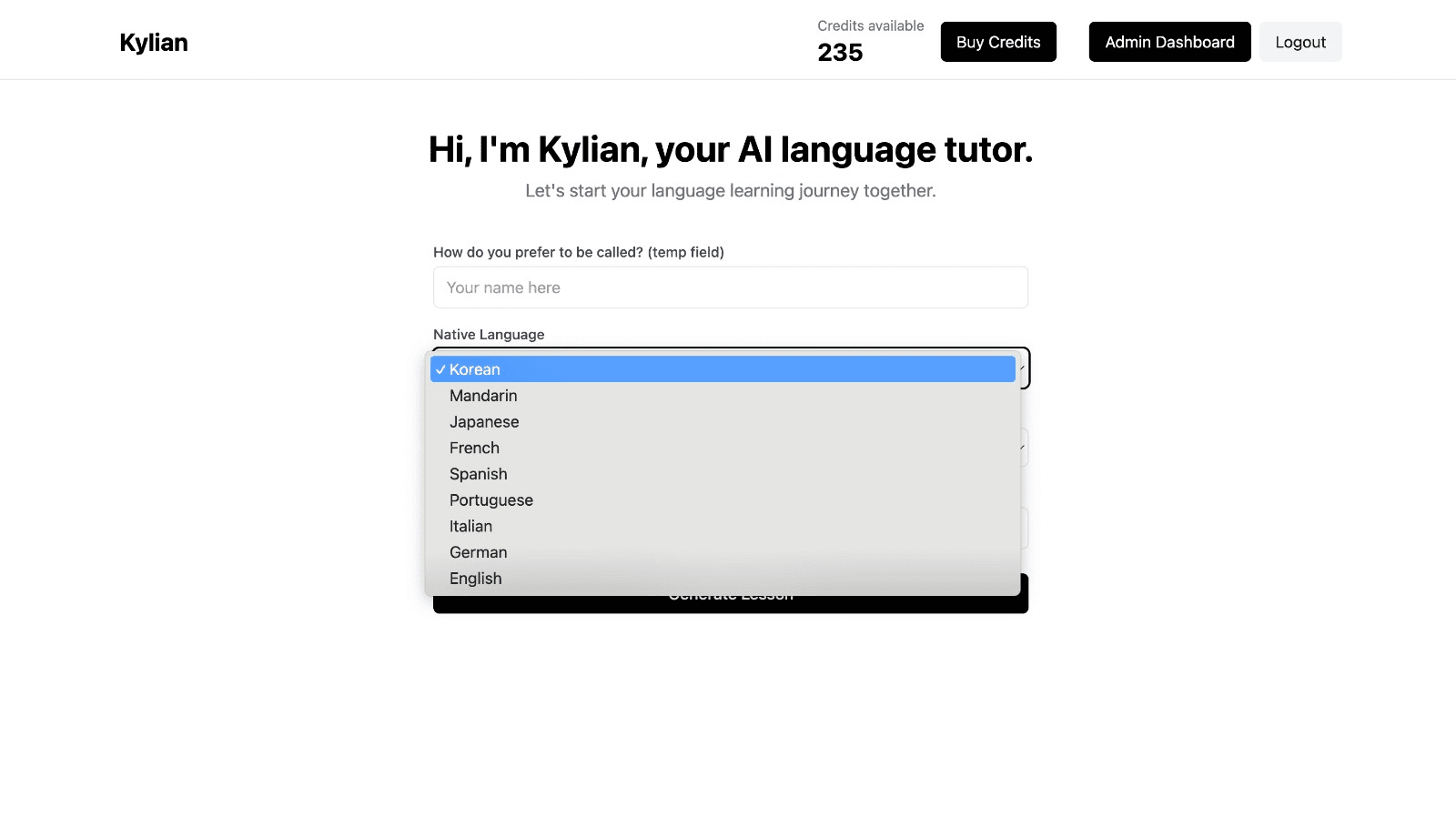
This personalization removes the frustration and confusion that are so common in traditional language learning.
Choose a specific topic you want to learn
Frustrated by language lessons that never cover exactly what you need? Kylian can teach you any aspect of a language—from pronunciation to advanced grammar—by focusing on your specific goals.
Avoid vague requests like “How can I improve my accent?” and be precise: “How do I pronounce the R like a native English speaker?” or “How do I conjugate the verb ‘to be’ in the present tense?”
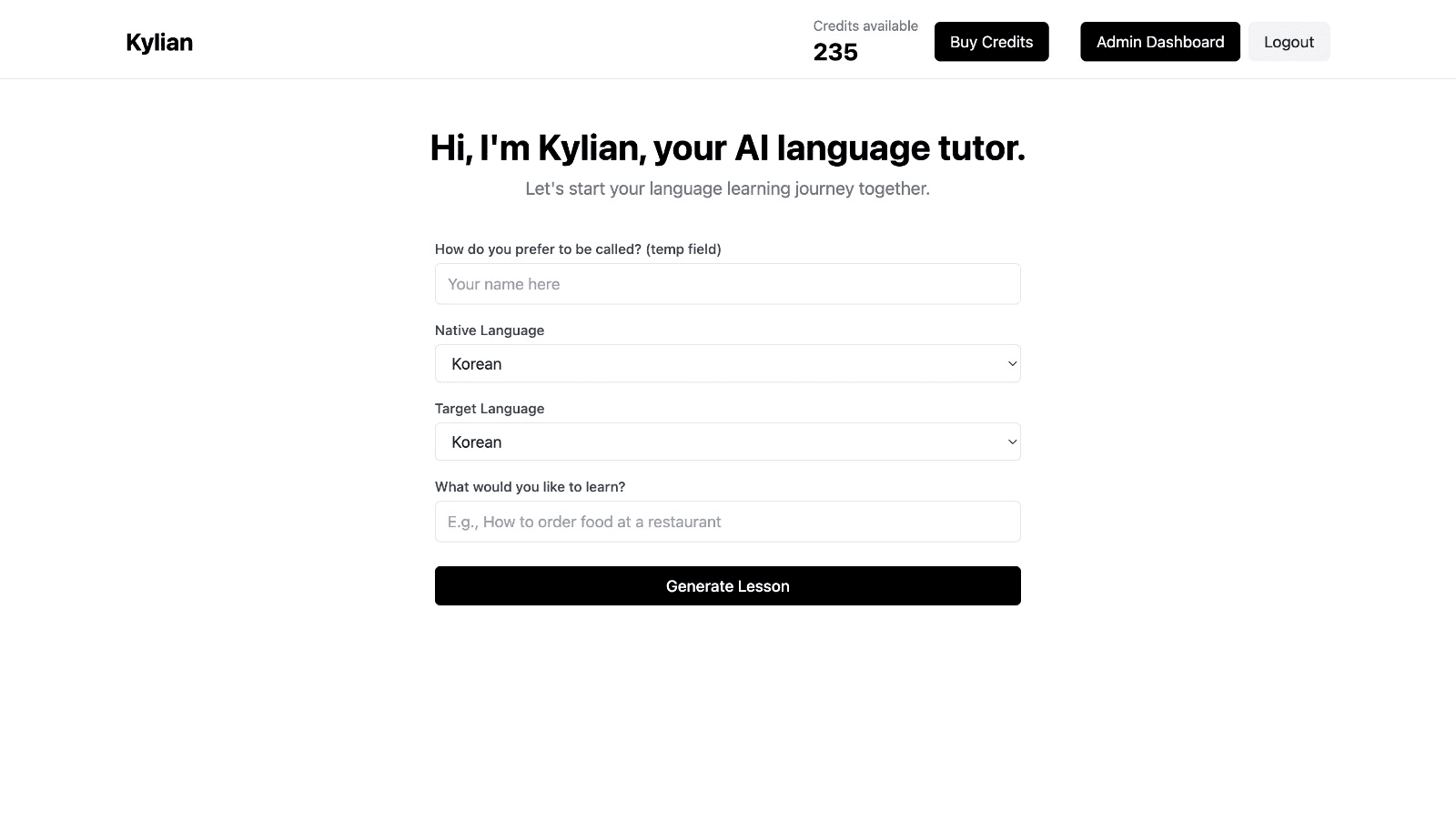
With Kylian, you’ll never again pay for irrelevant content or feel embarrassed asking “too basic” questions to a teacher. Your learning plan is entirely personalized.
Once you’ve chosen your topic, just hit the “Generate a Lesson” button, and within seconds, you’ll get a lesson designed exclusively for you.
Join the room to begin your lesson
The session feels like a one-on-one language class with a human tutor—but without the high price or time constraints.

In a 25-minute lesson, Kylian teaches exactly what you need to know about your chosen topic: the nuances that textbooks never explain, key cultural differences between French and your target language, grammar rules, and much more.

Ever felt frustrated trying to keep up with a native-speaking teacher, or embarrassed to ask for something to be repeated? With Kylian, that problem disappears. It switches intelligently between French and the target language depending on your level, helping you understand every concept at your own pace.
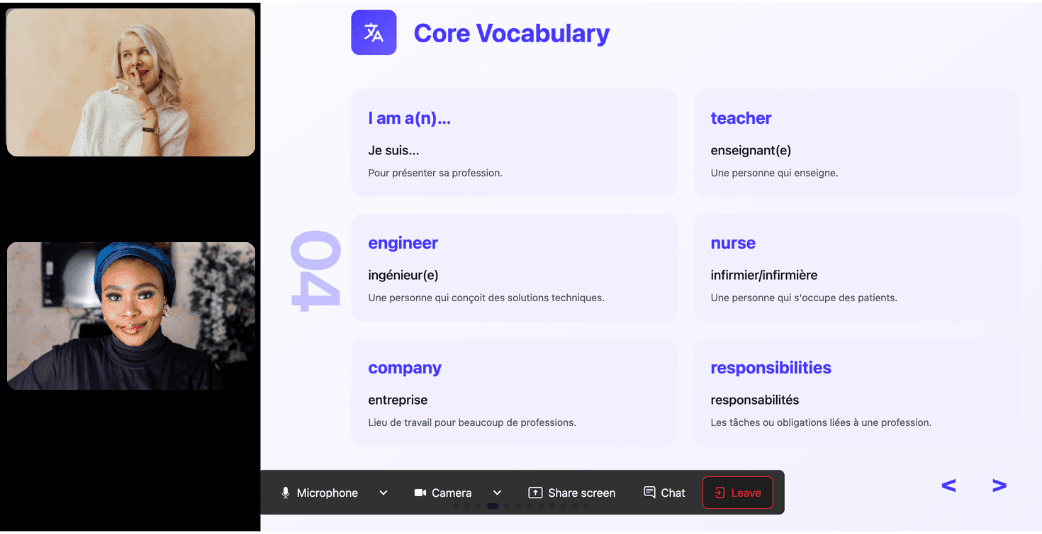
During the lesson, Kylian uses role-plays, real-life examples, and adapts to your learning style. Didn’t understand something? No problem—you can pause Kylian anytime to ask for clarification, without fear of being judged.

Ask all the questions you want, repeat sections if needed, and customize your learning experience in ways traditional teachers and generic apps simply can’t match.

With 24/7 access at a fraction of the cost of private lessons, Kylian removes all the barriers that have kept you from mastering the language you’ve always wanted to learn.
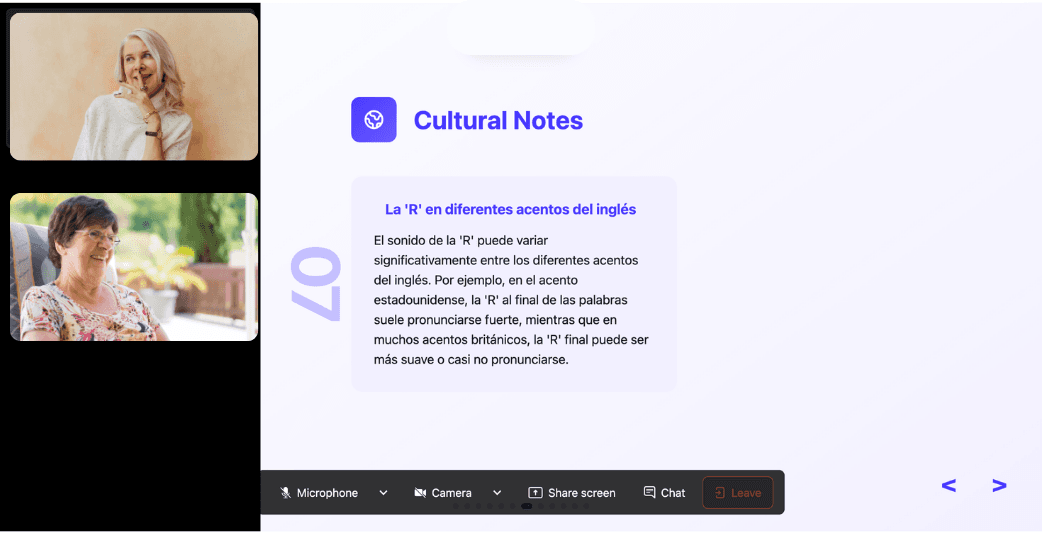
Similar Content You Might Want To Read

What Does DC Comics Stand For: Complete Guide
DC Comics stands for "Detective Comics," a name that traces back to the company's foundational publication launched in 1937. This seemingly simple answer, however, represents only the surface of a corporate identity that has evolved through decades of mergers, acquisitions, and strategic repositioning within the entertainment industry. The acronym reveals something profound about the company's origins and mission. Detective Comics wasn't just another comic book—it introduced Batman to the world in issue #27, fundamentally altering the trajectory of American popular culture. Understanding what DC Comics stands for requires examining not just the literal meaning, but the strategic decisions that transformed a small publishing house into a multimedia entertainment empire.

What Does the Phrase "Gravy Train" Mean in English?
The English language brims with colorful idioms that often perplex non-native speakers while simultaneously enriching communication for those who master them. Among these expressions, "gravy train" stands out as a particularly vivid metaphor that captures a specific economic reality. Understanding this phrase unlocks not just a linguistic tool but a window into cultural attitudes toward wealth, effort, and opportunity. When we examine expressions like "gravy train," we're not merely parsing words—we're decoding cultural DNA. These idioms reveal collective values, historical contexts, and societal perspectives that simple definitions cannot capture. The phrase "gravy train" merits analysis precisely because it encapsulates a complex nexus of ideas about prosperity, luck, and sustainability that transcends mere slang.

Direct and Indirect Speech: Rules for Clear Communication
Mastering the difference between direct and indirect speech represents a crucial milestone for anyone seeking proficiency in English grammar. These two speech forms govern how we report conversations and statements, dramatically influencing meaning, tone, and impact. Understanding when and how to convert between them enables more sophisticated writing and speaking abilities while preventing misrepresentation of others' words.

Applications For vs. In : Core Differences (English)
The prepositions "for" and "in" may appear interchangeable when discussing applications in relation to English, but they create substantially different meanings that reflect distinct conceptual relationships. This comprehensive analysis examines the semantic, grammatical, and practical distinctions between "applications FOR English" and "applications IN English," providing language learners and educators with precise understanding of these prepositions in context.

60 English Verbs for Beginners: Building Your Foundation
Learning English requires a strategic approach. When faced with thousands of words to memorize, knowing which ones to prioritize makes all the difference in your progress. Verbs—the action words that drive your sentences—form the backbone of effective communication. Master the right ones first, and you'll achieve conversational ability much faster.

Better Ways to Say "I Like" and "I Don't Like" in English
Do you find yourself repeatedly using the same phrases to express your preferences? The ability to articulate what you enjoy or dislike with precision and variety not only enriches your conversations but also demonstrates language proficiency. This article explores alternative expressions to the common "I like" and "I don't like" statements, providing you with a diverse vocabulary arsenal to communicate your preferences more effectively.